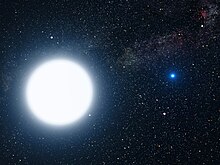Stars are not spread uniformly across the universe, but are normally grouped into galaxies along with interstellar gas and dust. A typical galaxy contains hundreds of billions of stars, and there are more than 2 trillion (1012) galaxies.[87] Overall, there are as many as an estimated 1×1024 stars[1][88] (more stars than all the grains of sand on planet Earth).[89][90][91] While it is often believed that stars only exist within galaxies, intergalactic stars have been discovered.[92]
A multi-star system consists of two or more gravitationally bound stars that orbit each other. The simplest and most common multi-star system is a binary star, but systems of three or more stars are also found. For reasons of orbital stability, such multi-star systems are often organized into hierarchical sets of binary stars.[93] Larger groups called star clusters also exist. These range from loose stellar associations with only a few stars, up to enormous globular clusters with hundreds of thousands of stars. Such systems orbit their host galaxy.
It has been a long-held assumption that the majority of stars occur in gravitationally bound, multiple-star systems. This is particularly true for very massive O and B class stars, where 80% of the stars are believed to be part of multiple-star systems. The proportion of single star systems increases with decreasing star mass, so that only 25% of red dwarfs are known to have stellar companions. As 85% of all stars are red dwarfs, most stars in the Milky Way are likely single from birth.[94]
The nearest star to the Earth, apart from the Sun, is Proxima Centauri, which is 39.9 trillion kilometres, or 4.2 light-years. Travelling at the orbital speed of the Space Shuttle (8 kilometres per second—almost 30,000 kilometres per hour), it would take about 150,000 years to arrive.[95] This is typical of stellar separations in galactic discs.[96] Stars can be much closer to each other in the centres of galaxies and in globular clusters, or much farther apart in galactic halos.
Due to the relatively vast distances between stars outside the galactic nucleus, collisions between stars are thought to be rare. In denser regions such as the core of globular clusters or the galactic center, collisions can be more common.[97] Such collisions can produce what are known as blue stragglers. These abnormal stars have a higher surface temperature than the other main sequence stars with the same luminosity of the cluster to which it belongs.



Walang komento:
Mag-post ng isang Komento